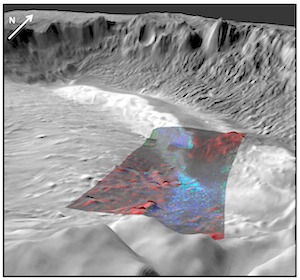 The Arabia Terra region of Mars is an ancient, very heavily cratered region about 5,100 kilometers (3,170 miles) across, roughly the length of the United States! Arabia contains some of the oldest rocks on Mars. It is one of two very large regions – the other being the Tharsis volcanic plateau – that is almost completely covered in accumulations of windblown dust. However the wind and gravity-driven processes on slopes can also strip the dust away. This image shows an exposure of the underlying igneous rock forming Arabia, containing mafic (magnesium- and iron-rich) minerals that make up most of Mars’ crust. The blue coloring shows a mineral called pyroxene, the dominant silicate mineral in most Martian igneous rocks. More CRISM images.
The Arabia Terra region of Mars is an ancient, very heavily cratered region about 5,100 kilometers (3,170 miles) across, roughly the length of the United States! Arabia contains some of the oldest rocks on Mars. It is one of two very large regions – the other being the Tharsis volcanic plateau – that is almost completely covered in accumulations of windblown dust. However the wind and gravity-driven processes on slopes can also strip the dust away. This image shows an exposure of the underlying igneous rock forming Arabia, containing mafic (magnesium- and iron-rich) minerals that make up most of Mars’ crust. The blue coloring shows a mineral called pyroxene, the dominant silicate mineral in most Martian igneous rocks. More CRISM images.
-
Recent Posts
Archives
Links
general
mission instruments
- CRISM: Compact Reconnaissance Imaging Spectrometer for Mars
- CTX: Context Camera
- HiRISE: High Resolution Imaging Science Experiment
- MARSIS: Mars Advanced Radar for Subsurface and Ionosphere Sounding
- SHARAD: Shallow Radar
- THEMIS: Thermal Emission Imaging System
missions
- All Mars missions list
- Curiosity rover
- ExoMars
- Hope (al-Amal) orbiter
- InSight
- Mars Atmosphere and Volatile Evolution Mission (MAVEN)
- Mars Exploration Rovers (MER)
- Mars Express (MEX)
- Mars Odyssey
- Mars Orbiter Mission (MOM) / Mangalyaan
- Mars Reconnaissance Orbiter (MRO)
- Mars Science Laboratory (MSL)
- Perseverance Rover
- Tianwen-1 orbiter/rover
news








